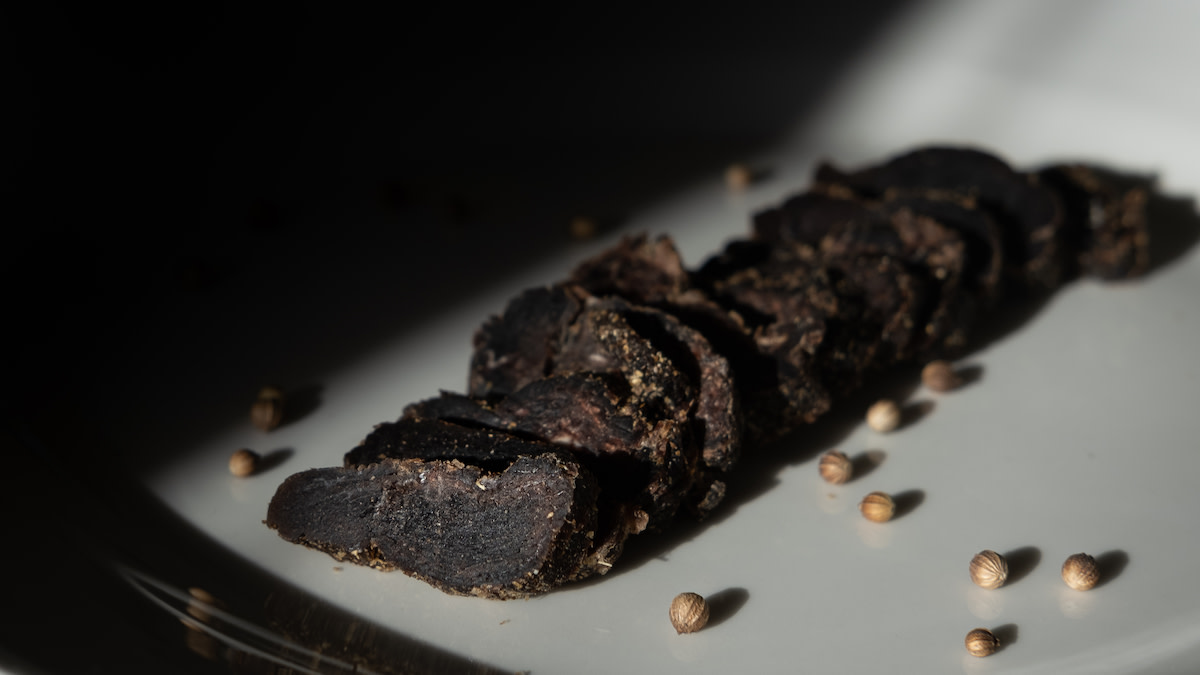
Course
Small Bites
Duration
4 to 14 days
Steven Rinella recently posed a thought-provoking question: “It would be interesting to know how many pounds of game meat get turned into jerky every year in the United States.” I don’t have an answer, but I bet the quantity is enough to tire as many tastebuds as mandibles.
As temperatures dip and the game seasons close, hunters across the country will fill time bathing this year’s kill in soy sauce. There’s nothing wrong with salty soy but, if you’re tired of jerky, I would like to introduce you to a similar but substantially different method of meat preservation: biltong.
Biltong is a form of meat curing that originated in the southern nations of Africa. The method uses simple air drying rather than low heat or smoking. Pretty much all you have to do is a simple vinegar marinade and spice dusting, followed by hanging the meat for up to 14 days. Then it’s cured and ready for long rides in the backpack. The relative simplicity of this recipe compared to something like prosciutto makes it a great way to dip your toes into the cured meat world without becoming overwhelmed.
Ingredients
- 5 lb. game meat, preferably roasts
- 6 tbsp. apple cider vinegar
- 4 tbsp. coriander seeds
- 3 tbsp. non-iodized salt
- 1 tbsp. ground black pepper
Also works with
Preparation
- Following the grain of the meat, cut the roast into 1-inch-thick strips. The length of the strip doesn’t matter.
- Rub the salt, coriander, and pepper onto the all sides of the meat slices. Reserve a teaspoon of coriander for later use. Place meat into a non-metallic bowl and add the vinegar.
- Marinate meat in the fridge for 24 hours, mixing occasionally. After a day, remove from the fridge and dry with paper towels. Sprinkle the rest of the coriander onto the meat.
- Hang the strips in a well-ventilated area and allow to dry for 4 to 14 days. Use or build a biltong box if humidity exceeds 40% (see notes). The biltong should not feel squishy when pinched. It’s ready when the meat has the consistency of a leather belt.
- Cut across the grain into packable slices and eat like jerky.
2
Notes
- Many websites sell or share instructions on how to make biltong boxes (small curing houses) but it is possible to complete the process without one in a dry environment.
- Large, clean fish hooks work well as hangers.
- Game meat is preferred for this recipe due to its lean composition. It’s best to avoid pork or bear meat because there is no actual cooking in the process and all that fat could go rancid.
- Keep an eye out for mold in warm and humid conditions! Cured meats are especially susceptible to mold, which can be dangerous to consume. Be sure to use clean kitchen utensils and bowls. Humidity should be below 40% to discourage mold growth, according to the USDA.
Steven Rinella recently posed a thought-provoking question: “It would be interesting to know how many pounds of game meat get turned into jerky every year in the United States.” I don’t have an answer, but I bet the quantity is enough to tire as many tastebuds as mandibles.
As temperatures dip and the game seasons close, hunters across the country will fill time bathing this year’s kill in soy sauce. There’s nothing wrong with salty soy but, if you’re tired of jerky, I would like to introduce you to a similar but substantially different method of meat preservation: biltong.
Biltong is a form of meat curing that originated in the southern nations of Africa. The method uses simple air drying rather than low heat or smoking. Pretty much all you have to do is a simple vinegar marinade and spice dusting, followed by hanging the meat for up to 14 days. Then it’s cured and ready for long rides in the backpack. The relative simplicity of this recipe compared to something like prosciutto makes it a great way to dip your toes into the cured meat world without becoming overwhelmed.
Ingredients
- 5 lb. game meat, preferably roasts
- 6 tbsp. apple cider vinegar
- 4 tbsp. coriander seeds
- 3 tbsp. non-iodized salt
- 1 tbsp. ground black pepper
Also works with
Preparation
- Following the grain of the meat, cut the roast into 1-inch-thick strips. The length of the strip doesn’t matter.
- Rub the salt, coriander, and pepper onto the all sides of the meat slices. Reserve a teaspoon of coriander for later use. Place meat into a non-metallic bowl and add the vinegar.
- Marinate meat in the fridge for 24 hours, mixing occasionally. After a day, remove from the fridge and dry with paper towels. Sprinkle the rest of the coriander onto the meat.
- Hang the strips in a well-ventilated area and allow to dry for 4 to 14 days. Use or build a biltong box if humidity exceeds 40% (see notes). The biltong should not feel squishy when pinched. It’s ready when the meat has the consistency of a leather belt.
- Cut across the grain into packable slices and eat like jerky.
2
Notes
- Many websites sell or share instructions on how to make biltong boxes (small curing houses) but it is possible to complete the process without one in a dry environment.
- Large, clean fish hooks work well as hangers.
- Game meat is preferred for this recipe due to its lean composition. It’s best to avoid pork or bear meat because there is no actual cooking in the process and all that fat could go rancid.
- Keep an eye out for mold in warm and humid conditions! Cured meats are especially susceptible to mold, which can be dangerous to consume. Be sure to use clean kitchen utensils and bowls. Humidity should be below 40% to discourage mold growth, according to the USDA.






Reviews